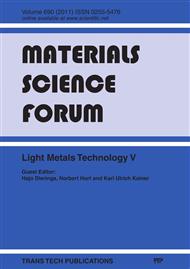p.443
p.447
p.451
p.455
p.459
p.465
p.469
p.473
p.477
Effect of Iron Addition to Aluminium on the Structure and Properties of Wires Used for Electrical Purposes
Abstract:
Eight hypoeutectic aluminium alloys with iron content within the range of 0.07-1.09% by weight, were examined. The structure, the mechanical and electrical properties of wires used for electrical purposes were studied. The batch material for the drawing process was wire rod obtained from the continuous casting and rolling line by Continuus-Properzi method. It has shown a linear relationship between mechanical properties of wire rod, a higher plasticity of wire after drawing process and an increase in thermal resistance of the material with increasing iron content. The findings enable to draw conclusions of basic and application characteristics, pointing to the possibility of using aluminium with higher iron content in the wire drawing process of small diameter and microwires for the production of automotive bundles, accumulator cables and winding wires.
Info:
Periodical:
Pages:
459-462
Citation:
Online since:
June 2011
Authors:
Keywords:
Price:
Сopyright:
© 2011 Trans Tech Publications Ltd. All Rights Reserved
Share:
Citation:


